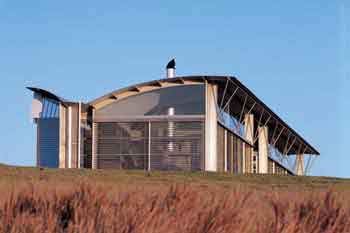

Australian Architect Receives Pritzker Prize
By HERBERT MUSCHAMP
April 15, 2002


Glenn Murcutt of Australia has won the Pritzker Architecture Prize for 2002; the announcement is to be made today by the Hyatt Foundation, which sponsors the award. Mr. Murcutt, 66, lives and practices in Sydney. The prize, which carries a $100,000 grant, is to be presented at a ceremony on May 29 at the Campidoglio in Rome.
Mr. Murcutt is best known as a pioneer in sustainable, or green, architecture, which attempts to diminish the impact of buildings on the natural environment. His designs are formally rigorous, minimal structures that recall the work of Charles and Ray Eames. But Mr. Murcutt's selection by the Pritzker jury can be seen as an acknowledgment that sustainability now overrides aesthetic criteria in the urbanizing world.
Environmental advocates estimate that sealed buildings produce half the world's greenhouse gases. Much of this pollution has become concentrated in the atmosphere over Australia, where the ozone layer has been damaged by emissions that can take up to 15 years to migrate from industrialized nations in the Northern Hemisphere to Australia and elsewhere in the Southern Hemisphere.
For Mr. Murcutt, who also breeds livestock, this damage has been felt beyond architecture. To contend with the hazards of harsh ultraviolet radiation penetrating a compromised ozone layer, "I have had to change my animals from white to black-furred," he said in a recent telephone interview.
Mr. Murcutt, who cites Freud, Jung and Thoreau among his influences, is a solo practitioner. All aspects of a building's design are rendered by his own hand. There is a three-year waiting list for prospective clients. Most of his projects are private houses.
This personal approach echoes that of early modern architects like Frank Lloyd Wright and Mies van der Rohe, whose work was rooted in the craft tradition. Mr. Murcutt's work is, in turn, a further development of Miesian spareness, in which the surrounding landscape provides a richness not seen in the design itself.
Mr. Murcutt's public works include a local history museum and visitors center in Kempsey, New South Wales; a Roman Catholic presbytery and community hall in Sydney; a visitors center in the Kakadu National Park, Northern Territory; and the Arthur and Yvonne Boyd Education Center in Riversdale, New South Wales. His innovations in sustainable design have also been adopted by architects for large projects in urban settings.
Pritzker Prize watchers may note that it has been 11 years since an American architect received this honor, and many may suspect that this is not a simple case of oversight.
The Pritzker jurors are J. Carter Brown, Giovanni Agnelli, Ada Louise Huxtable (a former architecture critic for The New York Times), Carlos Jimenez, Jorge Silvetti and Lord Rothschild.
Copyright 2002 The New York Times Company